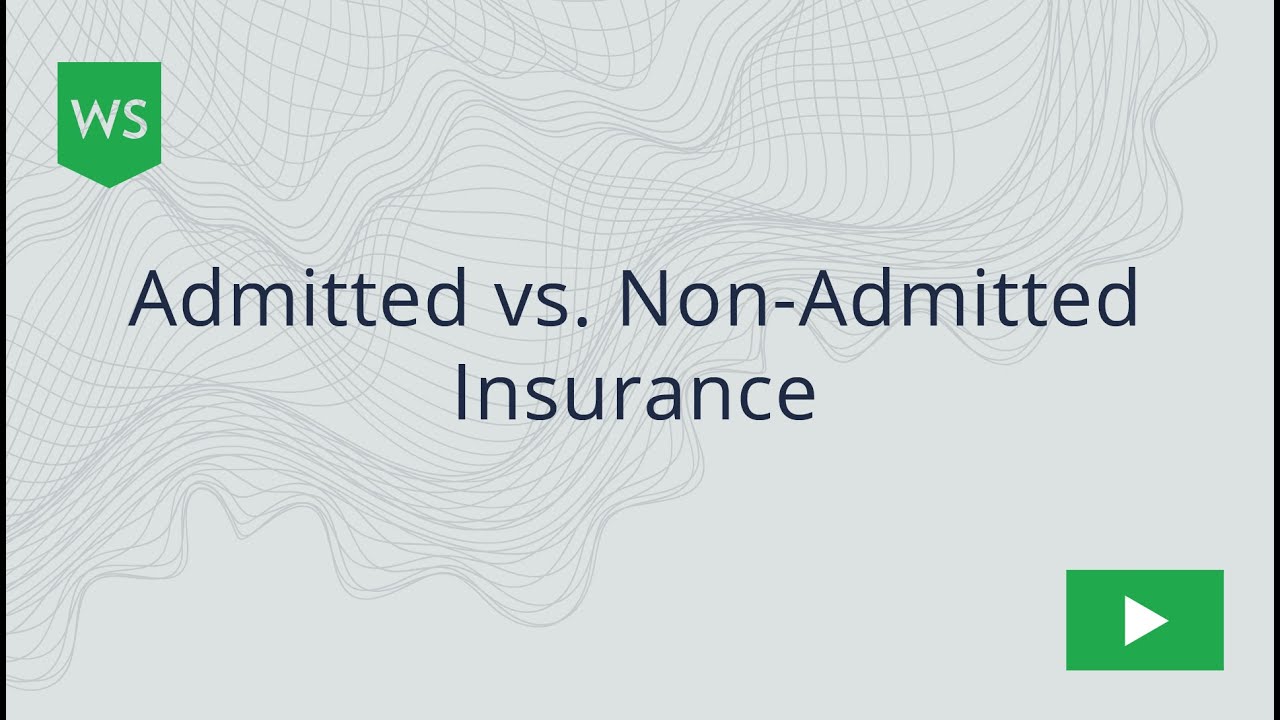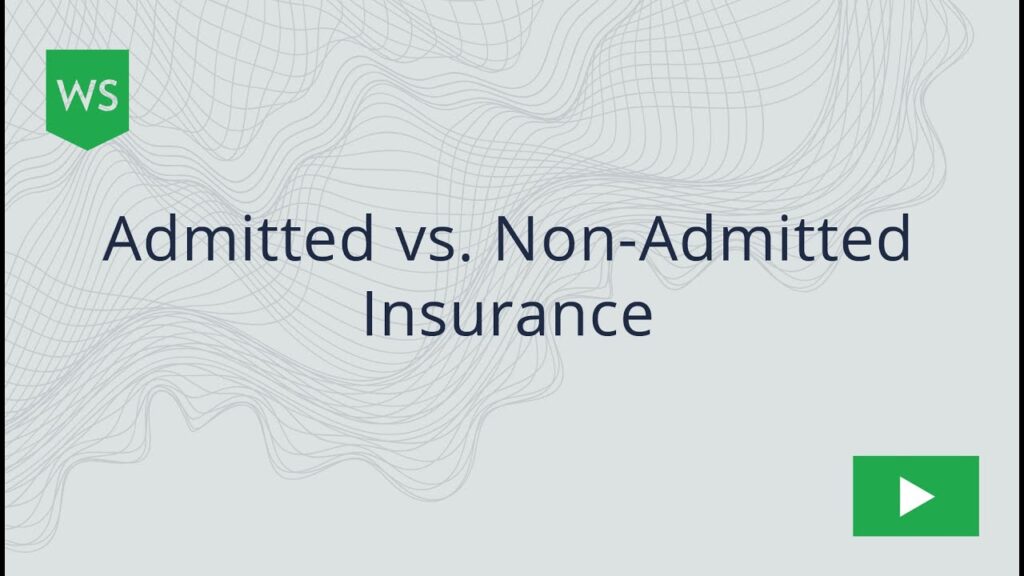Admitted Insurance

Admitted insurance refers to insurance coverage provided by insurance companies that have been approved and licensed by the state insurance department in which they operate. These companies have met specific financial and operational requirements to ensure their ability to pay claims and provide reliable insurance services.
Examples of admitted insurance companies include well-known insurers such as State Farm, Allstate, and Geico. These companies have undergone a rigorous vetting process by state regulators to ensure their financial stability, solvency, and adherence to ethical business practices.
Benefits of Purchasing Admitted Insurance
Purchasing admitted insurance offers several benefits:
- Financial Security: Admitted insurance companies are subject to strict financial regulations, ensuring they have adequate reserves to cover claims and maintain solvency.
- Regulatory Oversight: Admitted insurers are closely monitored by state insurance departments, which provides an additional layer of protection for policyholders.
- Access to State Guaranty Funds: In the event of an insurance company’s insolvency, policyholders with admitted coverage may be eligible for protection from state guaranty funds, which help cover unpaid claims.
- Peace of Mind: Knowing that your insurance coverage is provided by a reputable and financially sound company can give you peace of mind and confidence in the protection you have.
Non-Admitted Insurance
Non-admitted insurance, also known as surplus lines insurance, is a type of insurance that is not approved or regulated by a state’s insurance department. This means that the insurance company is not subject to the same rules and regulations as admitted insurance companies, and may not be able to provide the same level of protection.
Non-admitted insurance companies are often used to provide coverage for high-risk or specialized risks that are not available from admitted insurance companies. For example, non-admitted insurance companies may provide coverage for medical malpractice, professional liability, or aviation risks.
Risks Associated with Purchasing Non-Admitted Insurance
There are a number of risks associated with purchasing non-admitted insurance. These risks include:
- The insurance company may not be financially sound and may not be able to pay claims.
- The insurance company may not be subject to the same rules and regulations as admitted insurance companies, and may not be able to provide the same level of protection.
- The policy may not be enforceable in court.
- The insured may not be able to get the same level of customer service from a non-admitted insurance company as they would from an admitted insurance company.
Comparison of Admitted vs. Non-Admitted Insurance
Admitted and non-admitted insurance policies have distinct characteristics that affect their coverage and financial stability. Understanding these differences is crucial when choosing the right insurance for your needs.
Features of Admitted and Non-Admitted Insurance
| Feature | Admitted Insurance | Non-Admitted Insurance |
|---|---|---|
| Regulation | Regulated by state insurance departments | Not regulated by state insurance departments |
| Financial Stability | Insurers must meet state solvency requirements | Insurers may not be subject to the same solvency requirements |
| Claims Handling | Claims are handled through state-regulated mechanisms | Claims may be handled directly with the insurer |
| Availability | Widely available through licensed insurance agents | May not be available through all insurance agents |
| Premiums | Typically lower than non-admitted insurance | Typically higher than admitted insurance |
Factors to Consider When Choosing
When choosing between admitted and non-admitted insurance, consider the following factors:
- Coverage needs: Determine if the insurance coverage provided by admitted or non-admitted policies meets your specific requirements.
- Financial stability: Assess the financial strength and solvency of the insurance companies offering admitted and non-admitted policies.
- Claims handling: Consider the claims handling process and the potential delays or complications associated with each type of insurance.
- Availability: Check the availability of admitted and non-admitted insurance options through your preferred insurance agents.
- Premiums: Compare the premium costs of admitted and non-admitted policies to determine the best value for your money.
Situations Where Admitted or Non-Admitted Insurance May Be More Appropriate
- Admitted insurance may be more suitable:
- When you need insurance coverage that is widely recognized and regulated.
- When you prioritize financial stability and want to ensure your claims are handled through state-regulated mechanisms.
- When you prefer to purchase insurance through licensed insurance agents.
- Non-admitted insurance may be more appropriate:
- When you need coverage that is not available through admitted insurers.
- When you are willing to pay higher premiums for more specialized or unique coverage.
- When you have a high-risk profile and cannot obtain coverage from admitted insurers.
Regulation of Admitted vs. Non-Admitted Insurance
Regulation of insurance companies ensures the protection of policyholders and the stability of the insurance market. Admitted and non-admitted insurance are subject to different regulatory frameworks.
Admitted Insurance
Admitted insurance is regulated by state insurance departments. To become admitted, an insurance company must meet certain financial and operational requirements. These requirements include:
- Maintaining adequate capital and surplus
- Filing financial statements and reports
- Complying with state insurance laws and regulations
Admitted insurance companies are subject to ongoing supervision by state insurance departments. This supervision includes regular financial examinations and reviews of policies and procedures.
Non-Admitted Insurance
Non-admitted insurance is regulated by the federal government, specifically by the Surplus Lines Insurance Association (SLIA). SLIA is a non-profit organization that provides oversight of non-admitted insurance companies.
To obtain a surplus lines license, a non-admitted insurance company must demonstrate financial stability and meet certain other requirements. However, the regulations for non-admitted insurance are generally less stringent than those for admitted insurance.
Differences in Regulation
The main difference in regulation between admitted and non-admitted insurance is the level of oversight. Admitted insurance companies are subject to more stringent regulation and ongoing supervision by state insurance departments. Non-admitted insurance companies are subject to less stringent regulation and oversight by the federal government.
This difference in regulation reflects the fact that admitted insurance is considered to be more secure and reliable than non-admitted insurance. Admitted insurance companies are required to meet higher financial and operational standards, and they are subject to ongoing supervision by state insurance departments.
Availability of Admitted vs. Non-Admitted Insurance
The availability of admitted and non-admitted insurance is influenced by various factors, including state regulations, insurer risk appetite, and market demand.
Factors Affecting Availability of Admitted Insurance
- State Regulations: Admitted insurers must comply with strict state regulations, including financial stability requirements and licensing standards. These regulations can limit the availability of admitted insurance in certain states or for specific types of risks.
- Insurer Risk Appetite: Admitted insurers typically have a lower risk appetite compared to non-admitted insurers. They may be more selective in underwriting policies and may not offer coverage for high-risk or niche markets.
Factors Affecting Availability of Non-Admitted Insurance
- State Regulations: Non-admitted insurers are not subject to the same strict regulations as admitted insurers. This allows them to offer coverage in states where admitted insurers are not available or for risks that admitted insurers are unwilling to cover.
- Market Demand: Non-admitted insurers often fill a gap in the market by providing coverage for unique or specialized risks that are not covered by admitted insurers.
Comparison of Availability in Different States
The availability of admitted and non-admitted insurance varies significantly across states. In some states, admitted insurers dominate the market, while in others, non-admitted insurers play a more significant role. This variation is influenced by factors such as state insurance laws, the presence of large commercial insurance markets, and the demand for specialized coverage.





